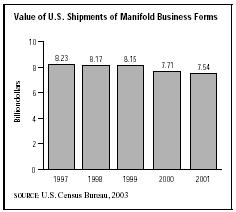SIC 2761
MANIFOLD BUSINESS FORMS
This category covers establishments primarily engaged in designing and printing, by any process, special forms for use in the operation of a business, in single and multiple sets, including carbonized or interleaved with carbon or otherwise processed for multiple reproduction.
NAICS Code(s)
323116 (Manifold Business Form Printing)
The status of the manifold business form industry is directly tied to the overall health of the U.S. business sector. A bustling economy, with established businesses reporting growth and new enterprises entering the field and surviving during their first years of operation, breeds a demand for business products. The establishments engaged in printing and manufacturing manifold business forms generally limit their product lines to such forms. The number of these establishments grew steadily throughout the 1970s, 1980s, and 1990s to reach nearly 950 by the turn of twenty-first century. The value of shipments for 2001 was $7.5 billion, down from $8.2 billion in 1997. In fact, shipments declined each year between 1997 and 2001 due in part to increasing imports, decreasing exports, increased laser printer usage for custom business forms, and rising paper costs. Industry leaders in the late 1990s were Standard Register Co., of Dayton, Ohio; New England Business Service, Inc., of Groton, Massachusetts; and Sierra Coatings Technologies, formerly called Shade/Allied, Inc., of De Pere, Wisconsin.

Manifold business forms are printed by commercial printing establishments and then sold to other businesses for use in all manner of transactions. Many of the establishments in this industry are regional in scope, gearing their sales and distribution efforts to a limited area. Such companies may market their products through an in-house sales team that targets area businesses, or they may sell their wares through retail office supply outlets or local printing shops. The products can be classified into two sub-categories: custom and stock. Custom forms are printed to a specific enterprise's particular needs, while stock forms can be sold to and used by a wide range of establishments. Stock manifold business forms include sequentially numbered tickets, cash receipt journals, message memo pads, invoice books, and spreadsheet books. Blank standard legal documents, such as lease agreements for landlords and incorporation forms, are also a vital component of the manifold business form industry. Most Americans encounter manifold business forms in a variety of daily public transactions, but their use is often vital to behind-the-scenes business operations as well.
In 2000 U.S. manifold business forms were exported to Canada, with $11.9 million; United Kingdom, with $433,000; Mexico, with $351,000; Australia, with $160,000; and the Netherlands with $154,000. The countries that exported to the United States in 2000 were Canada, with $8.1 million; Singapore, with $110,000; Mexico, with $83,000; United Kingdom, with $27,000; and Hong Kong, with $22,000. Between 1998 and 2000 imports increased from $6.2 million to $8.4 million, while exports over this time frame decreased from $16.6 million to $14.1 million.
The number of people employed by the industry began to decrease in the early 1990s. In 1987, the industry employed 53,000 people, of which production workers accounted for 37,100. As of 2000, however, the industry employed only 49,525 people, with production workers accounting for only 33,891. This decline was partly due to the growing use of computers in businesses of all sizes. Affordable laser printers can easily produce mass-volume custom business forms of all types, rendering the need to purchase standard manifold forms unnecessary. The proliferation of electronic financial transactions has also hurt the industry, resulting in a reduced demand for standard commercial checkbooks. In addition, many companies and government facilities have started to make their forms available for download over the Internet. Widespread use of laser printers for on-demand forms, along with other industry-related factors such as increasing paper prices, suggests a challenged industry, which is supported by both a decreased workforce and the reduced value of industry shipments.
Further Reading
"Top 25 U.S. Export Destinations for Manifold Business Forms." International Trade Administration, 10 April 2001. Available from http://www.ita.doc.gov/td/ocg/archive/aexp2761.htm .
"Top 25 U.S. Import Sources for Manifold Business Forms." International Trade Administration, 10 April 2001. Available from http://www.ita.doc.gov/td/ocg/archive/aimp2761.htm .
U.S. Census Bureau. "Statistics for Industry Groups and Industries: 2000." February 2002. Available from http://www.census.gov/prod/2002pubs/m00as-1.pdf .
——. "Value of Shipment for Product Classes: 2001 and Earlier Years." December 2002. Available from http://www.census.gov/prod/2003pubs/m01as-2.pdf .
Comment about this article, ask questions, or add new information about this topic: